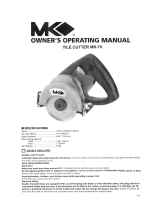
Page 5For technical questions, please call 1-888-866-5797.Item 62296
SAFETYOPERATIONMAINTENANCE SETUP
Kickback is the result of saw misuse and/
or incorrect operating procedures or
conditions and can be avoided by taking
proper precautions as given below:
a. Maintain a firm grip on the saw and position
your arms to resist kickback forces.
Position your body to either side of
the blade, but not in line with the blade.
Kickback could cause the saw to jump
backwards, but kickback forces can be controlled
by the operator, if proper precautions are taken.
b. When blade is binding, or when interrupting
a cut for any reason, release the Trigger
and hold the saw motionless in the material
until the blade comes to a complete stop.
Never attempt to remove the saw from the
work or pull the saw backward while the
blade is in motion or kickback may occur.
Investigate and take corrective actions to
eliminate the cause of blade binding.
c. When restarting a saw in the work
piece, center the saw blade in the
kerf and check that saw teeth are not
engaged into the material. If saw blade
is binding, it may walk up or kickback from
the work piece as the saw is restarted.
d. Support large panels to minimize the
risk of blade pinching and kickback.
Large panels tend to sag under their own
weight. Supports must be placed under
the panel on both sides, near the line of
cut and near the edge of the panel.
e. Do not use dull or damaged blades.
Unsharpened or improperly set blades
produce narrow kerf causing excessive
friction, blade binding and kickback.
f. Blade depth and bevel adjusting
locking levers must be tight and secure
before making cut. If blade adjustment shifts
while cutting, it may cause binding and kickback.
g. Use extra caution when making a
″plunge cut″ into existing walls or other
blind areas. The protruding blade may
cut objects that can cause kickback.
10. Check lower guard for proper closing before
each use. Do not operate the saw if lower
guard does not move freely and close instantly.
Never clamp or tie the lower guard into the
open position. If saw is accidentally dropped,
lower guard may be bent. Raise the lower guard
with the retracting handle and make sure it
moves freely and does not touch the blade or
any other part, in all angles and depths of cut.
11. Check the operation of the lower guard
spring. If the guard and the spring are
not operating properly, they must be
serviced before use. Lower guard may
operate sluggishly due to damaged parts,
gummy deposits, or a build-up of debris.
12. Lower guard should be retracted manually
only for special cuts such as ″plunge cuts″
and ″compound cuts.″ Raise lower guard
by retracting handle and as soon as blade
enters the material, the lower guard must
be released. For all other sawing, the lower
guard should operate automatically.
13. Always observe that the lower guard is covering
the blade before placing saw down on bench
or floor. An unprotected, coasting blade will cause
the saw to walk backwards, cutting whatever
is in its path. Be aware of the time it takes for
the blade to stop after Trigger is released.
14. DO NOT USE THIS SAW WITH THE
SAW HELD UPSIDE DOWN IN A VISE.
The saw is not designed for such use and
cannot be used safely in that position.
15. Do not use blades not designed specifically
for cutting tile without lubrication.
The guards of this saw are not designed to
protect against the failure of such blades.
16. Place the larger portion of the saw base
on the larger, supported part of the work
piece. This will help maintain balance and
control while the cut is completed.
17. Blades must be rated to at least the
maximum speed marked on the tool.
18. Do not use to cut metal.
19. Do not use for curve or angle cutting.
Doing so may damage Tile Saw blade.
20. Do NOT use with a “wet” attachment
or attempt to lubricate blade.
21. Do not use with a grinding wheel;
only use a diamond cutting disc.
22. Do not use damaged or cracked cutting disc.
23. Do not start Tile Saw with cutting blade
already set against tile surface.
24. Maintain labels and nameplates on the tool.
These carry important safety information.
If unreadable or missing, contact
Harbor Freight Tools for a replacement.
25. Avoid unintentional starting.
Prepare to begin work before turning on the tool.
26. Do not lay the tool down until it has come to
a complete stop. Moving parts can grab the
surface and pull the tool out of your control.
27. When using a handheld power tool,
maintain a firm grip on the tool with both
hands to resist starting torque.
28. Do not leave the tool unattended when it is plugged
into an electrical outlet. Turn off the tool, and
unplug it from its electrical outlet before leaving.
29. This product is not a toy.
Keep it out of reach of children.

















